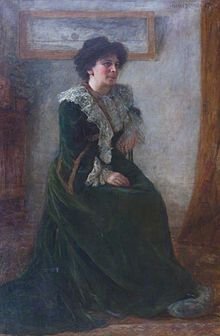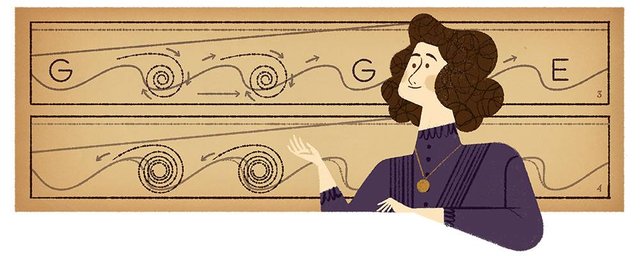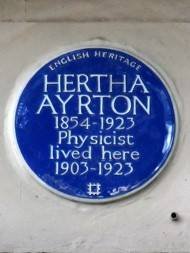Women in Science Series Contest 1: Hertha Marks Ayrton, the woman who illuminated science
)
Women, as in many other fields of work (despite all the limitations and abuses) have contributed to science and research, and on several occasions, they were not properly recognized. Recently, historians have carried out essays that expose the great contributions made by women in science and show the adversities they experienced and the strategies they developed so that their work was taken into account. As is the case of Hertha Marks Ayrton, who was the first woman to enter the Institution of Electrical Engineers, active member of the Political and Social Union of Women, founding member of the International Federation of University Women and the National Union of Women. Scientific workers, vice president of the British Federation of University Women, vice president of the National Union of Societies for the Suffrage of Women, fighter for women's liberation, protector of those who were persecuted for requesting a vote.

Life and career of Hertha Marks Ayrton

Born in a modest British family with the name of Phoebe Sarah Marks, in Great Britain, in the year 1854, she was agnostic and her adolescence took the name of "Hertha" from the homonymous heroine of a poem by Swinburne that criticized organized religion She studied at home and from 16 years of age worked as a governess. However, regardless of the sexual division that existed at that time in the workplace, decided to study mathematics at the Girton College in Cambridge, with the financial assistance of his tutor Richard Glazebrook. Hertha Marks Ayrton passed all the Mathematics tests, but did not receive the degree because, at that time, Cambridge only granted certificates and not academic degrees to women. That did not stop her and she managed to pass an external exam and obtained her Bachelor of Science degree from the University of London in 1881.

Between 1881 and 1883 Hertha Marks worked as a math teacher at home. He attended evening classes in physics at Finsbury Technical College where he studied science, during that time he met Professor William Ayrton, with whom he married in 1885. Hertha Marks helped her husband in his physics experiments, with time she became a recognized specialist in the study of the electric arc.
An electric arc is an electric discharge formed between two electrodes with different potential and placed in a rarefied gaseous atmosphere. When the electrodes come into contact, a semicircle-shaped discharge is produced, which is known as the electric or electric arc.
At the end of the 19th century, the electric arc was commonly used for public lighting, with the tendency to emit noise as the main problem. In 1895, Hertha Marks Ayrton wrote articles for The Electrician, where he explained that the noise was produced due to the oxygen that came in contact with the carbon rods used to create the arc. In 1899, she was the first woman to read her own work before the Institution of Electrical Engineers. Its study directed by titled "The whistle of the electric arc". Then, she was elected the first female member of that institute; The following was not until 1958. She requested to present her study to the Royal Society but it was not granted because she was a woman, John Perry presented it on her behalf in 1901. She was the first woman to obtain the Hughes Medal, awarded in 1906 in recognition to his research on the formation of waves in the dunes by the waves of the sea and his work in the electric arc. His work in the field of electrical engineering was recognized, both nationally and internationally. At the International Women's Congress held in London in 1899, Hertha Marks Ayrton presided over the physics section. He also spoke at the International Electricity Congress in Paris in 1900. His success there led the British Association for the Advancement of Science to allow women to join the general and private committees.

Hertha Marks Ayrton in 1904 became the first woman to read her paper before the Royal Society with her work The Origin and Growth of Ripple Marks, appearing again in 1908 and 1911. She also presented the results of her research before the audience of the British Association and the Physical Society. Hertha Marks Ayrton was part of the creation of the International Federation of University Women in 1919 and the National Union of Scientific Workers in 1920. She died of a blood infection on August 26, 1923 in New Cottage, North Lancing, Sussex, as a result of a sting. of mosquito.

Hertha Marks Ayrton transcended the field of sciences and she became a benchmark of liberal feminism. Recall that she was a woman, Jewish and scientific in the nineteenth century; It is unquestionably an example of personal struggle and self-improvement, managing to overcome and stand out in an area totally dominated by men. It is incredible to think that 100 years later, despite the great advances, women continue to fight for their rights, they continue to demand equality and respect. I thank @jasonbu for creating this space in which we can honor the women who opened the way, and who with their knowledge and struggle helped to develop and form the society that we currently have.

Congratulations! This post has been upvoted from the communal account, @minnowsupport, by ffelix26 from the Minnow Support Project. It's a witness project run by aggroed, ausbitbank, teamsteem, theprophet0, someguy123, neoxian, followbtcnews, and netuoso. The goal is to help Steemit grow by supporting Minnows. Please find us at the Peace, Abundance, and Liberty Network (PALnet) Discord Channel. It's a completely public and open space to all members of the Steemit community who voluntarily choose to be there.
If you would like to delegate to the Minnow Support Project you can do so by clicking on the following links: 50SP, 100SP, 250SP, 500SP, 1000SP, 5000SP.
Be sure to leave at least 50SP undelegated on your account.